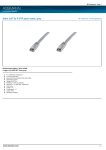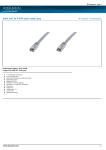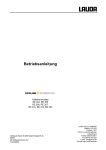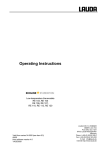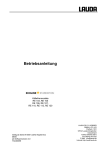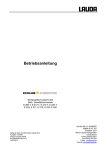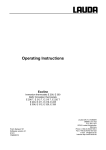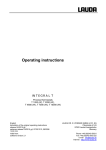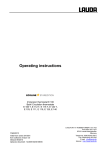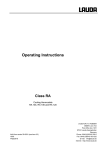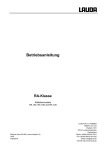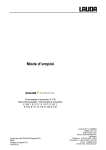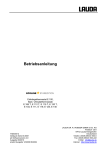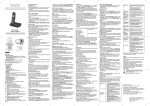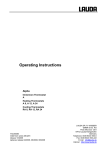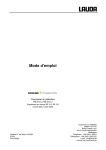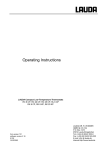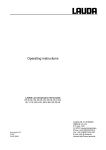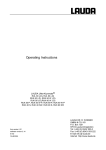Download Operating Instructions
Transcript
Operating Instructions Low-temperature thermostats RE 204, RE 205, RE 206, RE 207, RE 210, RE 212, RE 220 Valid from series 04-0001 (see item 8.4) 02/2009 replaces 02/2008, 08/2005 from software version 4.0 YACE0060 LAUDA DR. R. WOBSER GMBH & CO. KG Post-office box 1251 97912 Lauda-Koenigshofen Germany Phone: 0049 9343/ 503-0 Fax: 0049 9343/ 503-222 E-mail [email protected] Internet http://www.lauda.de eingefl. ÄA 05/027, 06/052, 06/089, 07/122, 07/164, 08/031, 08/127. ECOLINE Staredition Prefixed safety notes Before operating the equipment please read carefully all the instructions and safety notes. If you have any questions please phone us! (Ì 8.4) Follow the instructions on setting up, operation etc. This is the only way to avoid incorrect operation of the equipment and to ensure full warranty protection. • Transport the equipment with care! • The unit may NEVER be overturned nor put upside down! Equipment and its internal parts can be damaged: − by dropping − by shock. • Equipment must only be operated by technically qualified personnel! • Never operate the equipment without the heat transfer liquid (= bath liquid)! • Do not start up the equipment if: − it is damaged or leaking, − the supply cable is damaged. • Switch off the equipment and pull out the mains plug: − for servicing or repair, − before moving the equipment! • Drain the bath before moving the equipment! • Have the equipment serviced or repaired by properly qualified personnel only! The Operating Instructions include additional safety notes which are identified by a triangle with an exclamation mark. Carefully read the instructions and follow them accurately! Disregarding the instructions may have serious consequences, such as damage to the equipment, damage to property or injury to personnel! We reserve the right to make technical alterations! 19/02/2009/ YACE0060 Prefixed safety notes 3 ECOLINE Staredition Table of contents PREFIXED SAFETY NOTES ................................................................................................................................................... 3 1 SAFETY NOTES ........................................................................................................................................................ 6 1.1 1.2 GENERAL SAFETY NOTES ....................................................................................................................................... 6 OTHER SAFETY NOTES............................................................................................................................................ 7 2 BRIEF OPERATING INSTRUCTIONS.................................................................................................................. 8 3 CONTROL AND FUNCTIONAL ELEMENTS.................................................................................................... 10 4 UNIT DESCRIPTION.............................................................................................................................................. 11 4.1 4.2 4.3 4.4 4.5 4.6 4.7 4.8 4.9 ENVIRONMENTAL CONDITIONS ............................................................................................................................ 11 UNIT TYPES .......................................................................................................................................................... 11 BATHS ................................................................................................................................................................. 11 PUMPS.................................................................................................................................................................. 11 MATERIALS.......................................................................................................................................................... 12 TEMPERATURE INDICATION, CONTROL AND SAFETY CIRCUIT ............................................................................... 12 PROGRAMMER ..................................................................................................................................................... 12 INTERFACES ......................................................................................................................................................... 12 REFRIGERATION SYSTEM ..................................................................................................................................... 13 5 UNPACKING............................................................................................................................................................ 14 6 PREPARATIONS ..................................................................................................................................................... 15 6.1 6.2 6.3 6.4 7 ASSEMBLY AND SETTING UP ................................................................................................................................ 15 FILLING AND EMPTYING ....................................................................................................................................... 16 BATH LIQUIDS AND HOSE CONNECTIONS .............................................................................................................. 17 CONNECTION OF EXTERNAL CIRCUITS .................................................................................................................. 19 STARTING UP ......................................................................................................................................................... 20 7.1 CONNECTION TO THE SUPPLY ............................................................................................................................... 20 7.2 SWITCHING ON ..................................................................................................................................................... 20 7.3 SET POINT SELECTION (LEVEL 0) .......................................................................................................................... 21 7.4 MENU FUNCTIONS ................................................................................................................................................ 21 7.4.1 Refrigeration system (level 1) ..................................................................................................................... 22 7.4.2 Pump output ................................................................................................................................................ 22 7.4.3 Setting the set point resolution.................................................................................................................... 23 7.4.4 Programmer level (PGM) ........................................................................................................................... 24 7.4.4.1 Programme example................................................................................................................................ 24 7.4.4.2 Indicating/ altering of programme segments........................................................................................... 25 7.4.4.3 Number of programme running .............................................................................................................. 26 7.4.4.4 Starting of the programmer ..................................................................................................................... 27 7.4.4.5 Inserting/ deleting of program segments................................................................................................. 28 7.4.4.6 Holding/ continuing the programme ....................................................................................................... 30 7.4.4.7 Terminating the programme.................................................................................................................... 31 7.4.5 Parameters.................................................................................................................................................. 31 7.4.5.1 Setting the proportional band of the PID-controller ............................................................................... 32 7.4.5.2 Setting the reset time of the PID-controller ............................................................................................ 32 7.4.5.3 Selection of the interface......................................................................................................................... 33 7.4.5.4 Setting the Baud rate/ transfer rate (serial interface)............................................................................... 34 7.4.5.5 User calibration ....................................................................................................................................... 34 7.5 WARNING AND SAFETY FUNCTIONS ..................................................................................................................... 36 7.5.1 Overtemperature protection and testing ..................................................................................................... 36 7.5.2 Low-level protection and testing................................................................................................................. 37 7.5.3 Pump motor monitoring.............................................................................................................................. 37 7.5.4 Connection floating contact “Combination fault” 31 N............................................................................. 38 4 Table of contents 19/02/2009/ YACE0060 ECOLINE Staredition Other error messages ..................................................................................................................................38 7.5.5 7.6 SERIAL INTERFACES RS 232, RS 485....................................................................................................................39 7.6.1 RS 232 Interface ..........................................................................................................................................39 7.6.2 RS 485 Interface ..........................................................................................................................................40 7.6.3 Write commands (data commands to the thermostat)..................................................................................41 7.6.4 Read commands (data requested from the thermostat) ...............................................................................42 7.6.5 Error messages ............................................................................................................................................42 7.6.6 Driver software for LABVIEW® ...................................................................................................................42 8 MAINTENANCE.......................................................................................................................................................43 8.1 CLEANING ............................................................................................................................................................43 8.2 MAINTENANCE AND REPAIR..................................................................................................................................43 8.2.1 Testing the heat transfer liquid....................................................................................................................43 8.2.2 Maintenance of the refrigeration unit..........................................................................................................44 8.3 DISPOSAL INFORMATION ......................................................................................................................................44 8.3.1 Disposal of the refrigerant...........................................................................................................................44 8.3.2 Disposal of the packaging ...........................................................................................................................45 8.3.3 Note on repair..............................................................................................................................................45 8.4 ORDERING SPARES ................................................................................................................................................46 9 ACCESSORIES .........................................................................................................................................................47 10 TECHNICAL DATA.................................................................................................................................................48 11 CIRCUIT DIAGRAMS.............................................................................................................................................52 12 PIPE PLAN ................................................................................................................................................................56 CONFIRAMTION........................................................................................................................................61 Explanation of signs: Ì 19/02/2009/ YACE0060 Danger: This sign is used where there may be injury to personnel if a recommendation is not followed accurately or is disregarded. Note: Here special attention is drawn to some aspect. May include reference to danger. Reference: Refers to other information in different sections. Table of contents 5 ECOLINE Staredition 1 Safety notes 1.1 General safety notes A laboratory thermostat is intended for heating and pumping liquids according to the needs of the user. This leads to hazards by high temperatures, fire, and the general hazards by the use of electrical energy. The user is largely protected through the application of the appropriate standard specifications. Additional hazards may arise from the type of material being thermostated, e.g. when going above or below certain temperature levels or through breaking of the container and reaction with the heat carrier liquid. It is not possible to cover all possibilities; they remain largely within the responsibility and the judgement of the user. The unit must only be used as intended and as described in these Operating Instructions. This includes operation by suitably instructed qualified personnel. The units are not designed for use under medical conditions according to DIN EN 60601-1 or IEC 601-1! Electrical equipment for measurement, control and laboratory use EMC requirements DIN EN 61326-1 Class A: Operation only on networks without connected domestic areas. Class B: Equipment for operation on networks with connected domestic areas. For Europe only: The equipment according to EMC (electromagnetic compatibility) requirements DIN EN 61326-1 VDE 0843-20-1 (Ì 10). Use restriction To EMC standard DIN EN 61326-1: Class A devices must not be operated by in power networks with connected domestic areas! For the USA only: Instructions for Class A digital devices “This equipment has been tested and found to comply with the limits for Class A digital device, pursuant to Part 15 of the FCC (Federal Communication Commission) Rules. These limits are designed to provide reasonable protection against harmful interference when the equipment is operated in a commercial environment. This equipment generates, uses, and can radiate radio frequency energy and, if not installed and used in accordance with the instruction manual, may cause harmful interference to radio communications. Operation of this equipment in a residential area is likely to cause harmful interference in which case the user will be required to correct the interference at his own expense.” “This device complies with Part 15 of the FCC (Federal Communication Commission) Rules. Operation is subject to the following two conditions: (1) This device may not cause harmful interference, and (2) this device must accept any interference received, including interference that may cause undesired operation.” For Canada only: “This Class A digital apparatus complies with Canadian ICES-003” (ICES = Interference Causing Equipment Standards). « Cet appareil numérique de la classe A est conforme à la norme NMB-003 du Canada ». 6 Safety notes 19/02/2009/ YACE0060 ECOLINE Staredition 1.2 Other safety notes • Connect the unit only to grounded mains power socket (PE). • Parts of the bath cover may reach surface temperatures above 70 °C when operating at higher temperatures. Take care when touching it! • Use suitable hoses Ì 6.3 • Protect hoses with hose clips against slipping off. Avoid kinks in the hoses! • Check hoses from time to time for possible material defects! • Heat transfer tubing and other hot parts must not come into contact with the supply cable! • When using the thermostat as circulation thermostat, failure of tubing may lead to leaking of hot heat transfer liquid and become a danger to personnel and objects. • When no external consumer is connected to the thermostat the pump outflow must be closed (use closing plugs) or linked to the return! • Allow for expansion of the bath oils at elevated temperatures! • Depending on the bath liquid used and the mode of operation it is possible for toxic vapours to be produced. Ensure appropriate ventilation! • When changing the bath liquid from water to oil, for temperatures above 100 °C, carefully remove all traces of water, also from tubing and from the external consumer, otherwise Æ danger of burns through delayed boiling! • Always pull out the mains plug before cleaning, maintenance or moving the thermostat! • Repairs on the control unit and the refrigeration system must be carried out by properly qualified personnel only! • Values for temperature control and indicating accuracy apply under normal conditions according to DIN 12876. High-frequency electromagnetic fields may under special conditions lead to unfavourable values. This does not affect the safety! 19.02.09/ YACE0060 Safety notes 7 ECOLINE Staredition 2 Brief operating instructions This brief instruction shall give you the possibility to operate the unit quickly. For safe operation of the unit it is absolutely necessary to read carefully all the instructions and safety notes! 1. Assemble unit and add items as appropriate (Ì 6). Take care of the hose tubing connections (Ì 6.1 and 6.4). 2. Fill the unit with corresponding liquid (Ì 6.3). The units are designed for operation with non-flammable and flammable liquids to DIN EN 61010-2-010 IEC 61010-2-010. Æ Take care of the level of the bath liquid! (Ì 6.2) 3. Connect the unit only to a socket with a protective earth (PE) connection. Compare the information on the rating label with the supply details. 4. Set the over temperature cut-out point to a value clearly above ambient temperature (Ì 7.5.1). 5. Switch on at the mains switch 6. Setting of the functions Refrigeration system COOL Ì 7.4.1 Pump output PUMP Ì 7.4.2 Setpoint resolution RES Ì 7.4.3 8 Brief operating instructions 19/02/2009/ YACE0060 ECOLINE Staredition Programmer PGM Ì 7.4.4 Parameters PARA Ì 7.4.5 19/02/2009/ YACE0060 Brief operating instructions 9 ECOLINE Staredition 3 Control and functional elements LED green, Supply ON Menu functions Pump connections: – return to bath – pump outflow, pressure output (Ì labelling housing) Bath bridge Setting of the over temperature switch-off point Mains switch Bath cover RS 232/485 65S Alarm contact 31N 10 Control and functional elements 19/02/2009/ YACE0060 ECOLINE Staredition 4 Unit description 4.1 Environmental conditions The operation of the thermostats is only allowed under the following conditions as specified in DIN EN 61010-2-010:2003 and DIN EN 61010-1:2001. − Indoor use. − Altitude up to 2000 m above sea level. − Foundation must be dense, even, non-slippery and non-flammable. − Keep clear distance (Ì 6.1 Assembly and setting up). − Ambient temperature range (Ì 10). Use only within this range for an undisturbed operation. − Mains supply voltage fluctuations (Ì 10). − Maximum relative humidity 80 % for temperatures up to 31 °C, decreasing linearly to 50 % relative humidity at 40 °C. − Transient over voltage according to Installation Categories (Over voltage Categories) II − Pollution degree: 2. 4.2 Unit types The type designation of the Ecoline low-temperature thermostats consists of the letter R (identification as low-temperature unit), the control unit E 200 and the type of bath and refrigeration system. Example: Control unit E 200 and bath RE 004 produces Thermostat Type RE 204. Type RE 220 is supplied without bath cover. A bath cover is available as accessory (Ì 9). 4.3 Baths All units provide a stainless steel bath. The last two digits of the model no. correspond to the approximate total volume in Litres (e.g. bath RE 206 = approx. 6 Litre). Part of this volume may be used to insert objects. 4.4 Exception! Model no. RE 205 was especially optimised for tempering external vessels and therefore does not provide any usable bath volume for inserting objects. Pumps All units are equipped with a pressure pump with vario drive. The pump has an outflow with a rotatable bend which is connected to the pump nipple for external thermostating units. An additional outflow provides circulation inside the bath. By turning the setting knob it is possible to choose between both outlets or to divide the flows. The pump can be used for viscosities up to 150 mm²/s. However, to get an optimum accuracy of control a viscosity of < 30 mm²/s is recommended. One of five pump output steps can be selected using the operating menu. On small low-temperature thermostats (e.g. RE 204 or RE 206) and with operation as bath thermostat it is advisable to use output step 2. The advantage is a low heat generation while having a uniform circulation that means, that the thermostat can work without cooling down to just above ambient temperature. 19/02/2009/ YACE0060 Unit description 11 ECOLINE Staredition When operating as circulation thermostat with an external circuit it is preferable to use a larger flow rate in order to ensure a small temperature difference, especially at higher temperatures and in conjunction with oil as the bath liquid. The pump connection outflow can be closed off without causing any damage to the pump. Pump characteristics (Ì 10 Technical Data) 4.5 Materials All parts which come into contact with the bath liquid are made from high-grade materials appropriate to the operating temperature. These are rust-free stainless steel, PPS plastics and fluoride rubber. 4.6 Temperature indication, control and safety circuit The unit is equipped with a 2-line LCD-Display with additional symbols for indicating bath temperature and settings as well as operating states. The input of the set point and other additional adjustments are done using either two or three keys. Remote operation is possible via an electrically isolated RS 232 interface. A Pt100 temperature probe is used for measuring the actual temperature and for control. A second Pt100 serves as temperature probe for the safety circuit (over temperature protection) which is independent of the control function. A low-level protection switches off the heating on both poles in order to prevent dry operation of the heater. The pump is switched off electronically. The over temperature switch-off point is adjusted with a tool on a potentiometer and is always limited to 5 °C above the operating temperature range. A floating contact "Combination fault" is available. All settings and fault messages are stored in the memory in case of a supply failure or when the mains switch is set to “OFF”. The tubular heater is controlled from a modified PID controller through a triac circuit specially designed to be unaffected by supply variations and interference. 4.7 Programmer The units incorporate a programmer which can be used to run temperature programmes with up to 20 temperature-time-segments (Ì 7.4.4). 4.8 Interfaces Connector for fault (alarm) contact output and a serial RS 232/ RS 485 interface are located on the back of the control head. For further description of the interfaces see under Section 7.6 and 7 Starting up. 12 Unit description 19/02/2009/ YACE0060 ECOLINE Staredition 4.9 Refrigeration system The refrigeration system consists essentially of a hermetically sealed compressor. Heat of condensation and motor heat are dissipated by a fan-cooled finned condenser. Fresh air is drawn in at the front of the unit; warmed air is discharged at the back and to the sides. The ventilation openings must not be restricted in order to ensure proper air circulation. At working temperatures below approx. 30 °C the refrigeration system operates continuously to remove a certain amount of heat, with the heater acting in opposition to provide automatically controlled heating power. The compressors are fitted with a temperature monitor which responds both to the compressor temperature and to the motor current. In addition the cooling system is protected against excessive pressure by a pressure monitor. The refrigeration unit is switched on either automatically or manually through the operating menu (Ì 7.4.1). Types RE 205, RE 207, RE 210, RE 212, RE 220 are additionally provided with a cooling capacity adjustment which saves energy in many operating situations, reduces the load on the refrigeration system and produces a better temperature control. This feature, too, can be operated either automatically or manually. When the fault circuit is activated the refrigeration system is also switched off. Cooling curves (Ì 10 Technical Data) 19/02/2009/ YACE0060 Unit description 13 ECOLINE Staredition 5 Unpacking After the unit and accessories have been unpacked they have to be examined for possible transport damage. If there is any damage visible on the unit, the forwarding agent or the post office has to be notified so that the shipment can be examined. Please also inform the LAUDA Service Constant Temperature Equipment (Contact Ì 8.4). Standard accessories: Article number Quantity Designation Bath cover except RE 220 HDQ 084 1 Bath cover RE 004 only with RE 204 HDQ 086 1 Bath cover RE 012 only with RE 205, RE 210 and RE 212 HDQ 085 1 Bath cover FBC 020 only with RE 206 and RE 207 UD 435 1 Closing plug for all low-temperature thermostats for all low-temperature thermostats 14 EZB 260 1 Warning label “HOT” YACE 0060 1 Operating Instructions (this document) Unpacking for all low-temperature thermostats 19/02/2009/ YACE0060 ECOLINE Staredition 6 Preparations 6.1 Assembly and setting up − Place the unit on a flat surface. − The unit may NEVER be overturned or put upside down! − After transport and before starting up, store it standing in upright position for two hours if possible. − Do not cover the ventilation openings at the back of the unit and its lower part. Keep clear distance of at least 40 cm. − Adjust the flow setting knob so that when using the unit as bath thermostat (no external circulation) the flow emerges at the opening for the bath circulation, or link together the pump connections (see ill. 3). Operation with external consumer (circulation thermostat) (Ì 6.4) Adjustments of the pump outflows (Ì 6.4) Ill 1 Flow setting knob turned anticlockwise 19/02/2009/ YACE0060 Ill 1 Flow setting knob medium position Ill 3. Flow setting knob turned clockwise − When operating as bath thermostat without external consumer the pump connection outflow has to be closed (use closing plugs) or linked to the return. − At bath temperature above 70 °C the label the bath in a clearly visible position! Preparations supplied must be affixed on 15 ECOLINE Staredition 6.2 − The unit can be operated safely up to an ambient temperature of 40 °C. − Depending on the loading of the refrigeration system it may switch off temporarily especially at ambient temperatures above 35 °C. Elevated ambient temperatures also result in reduced cooling capacity. − When starting up the refrigeration system after it has been cut of operation for longer time it may take up to 30 min, depending on ambient temperature and unit type, before the nominal cooling capacity is reached. Filling and emptying Filling Close the drain cock. − Fill baths up to a maximum level of 20 mm below the bath bridge. − Optimum operation at 20-40 mm below the bath bridge. − Operation is possible down to 60 mm below the bath bridge. − The low-level cut-out operates approx. 90 mm below the bath bridge! − When using thermal oils it is necessary to allow for an expansion of approx. 10 %/ 100 °C. − When operating with an external consumer the total expansion takes place in the bath. Emptying Drain cock − − Switch off the thermostat, pull out the mains plug! − Drain the bath liquid through the drain cock Æ using tubing. − The units are designed for operation with non-flammable and flammable liquids to DIN EN 61010-2-010 IEC 61010-2-010! Flammable liquids can be operated up to no more than 25 °C below the fire point (Ì 6.3). − Observe the appropriate regulation when disposing of used heat transfer liquid. − When connecting an external consumer take care that the level of the bath liquid does not decrease too much Æ fill in heat carrier liquid if necessary. Do not drain the heat transfer liquid when it is hot or very cold (below 0 °C)! 16 Preparations 19/02/2009/ YACE0060 ECOLINE Staredition 6.3 Bath liquids and hose connections Heat transfer liquids LAUDA Designation Working temperature range Chemical Designation Viscosity (kin) Viscosity (kin) at Temperature Firepoint mm²/s at 20 °C mm²/s °C 1 -- -- LZB 120 LZB 220 LZB 320 Size Cat. No. Former designation from °C to °C Aqua 90 water 5...90 Kryo 30 G 100 -30...90 Monoethyleneglycol/water 4 50 at -25 °C -- LZB 109 LZB 209 LZB 309 Kryo 51 --- -50...120 Silicone oil 5 34 at -50 °C > 160 LZB 121 LZB 221 LZB 321 Kryo 20 160 MS -20...180 Silicone oil 11 28 at -20 °C > 230 LZB 116 LZB 216 LZB 316 Ultra 350 330 SCB 30...200 synthetic thermal oil 47 28 at 30 °C > 240 LZB 107 LZB 207 LZB 307 Therm 200 RDS 50 60...200 Silicone oil 54 28 ... 60 °C > 362 LZB 117 LZB 217 decalcified water 5l 10 l 20 l LZB 317 { At higher temperatures Æ Evaporation losses Æ Use bath covers (Ì 9). Distilled water or fully deionised water must only be used with the addition of 0,1 g sodium carbonate (Na2CO3)/ l water, otherwise Æ danger of corrosion! Water content falls after prolonged operation at higher temperatures Æ mixture becomes flammable (flash point 128 °C) Æ Check the mixture ratio with a dosimeter. Do not use in conjunction with EPDM tubing! − When selecting bath liquids it should be noted that performance must be expected to worsen at the lower limit of the operating temperature range due to increasing viscosity. The full operating range should only be utilised if really necessary. − The operating ranges of the bath liquids and tubing represent general data which may be limited by the operating temperature range of the unit. Silicone oil causes pronounced swelling of Silicone rubber Æ never uses Silicone oil with Silicone tubing! Safety data sheets are available on request! 19/02/2009/ YACE0060 Preparations 17 ECOLINE Staredition Hose connections Tubing type EPDM-tubing, non-insulated Int. dia. Ø mm 9 Temperature range °C Application Ref. No. 10...120 for all bath liquids except for Ultra 350 and mineral oils RKJ 111 10...120 for all bath liquids except for Ultra 350 and mineral oils RKJ 112 LZS 021 EPDM-tubing, non-insulated 12 EPDM-tubing insulated 12 ext. dia. approx. 35mm -60...120 for all bath liquids except for Ultra 350 and mineral oils Silicone tubing, non-insulated 11 -30...100 water, water/ glycol mixture RKJ 059 Silicone tubing insulated 11 ext. dia. 35mm approx . -60...100 water, water/ glycol mixture LZS 007 Viton 11 10...200 for all bath liquids RKJ 091 − EPDM- EPDM-tube not for Ultra 350 and mineral oils! − Silicone oil causes pronounced swelling of Silicone rubber Æ never uses Silicone oil with Silicone tubing! − Protect tubing with hose clips against slipping off. 18 Preparations 19/02/2009/ YACE0060 ECOLINE Staredition 6.4 Connection of external circuits Operation as circulation thermostat − When used as circulation thermostat, care for shortest hose connections with largest inner diameter as possible. This gives the best flow. − Connect 11-12mm int. diameter tubing (Ì 6.3) to the pump connector. − Pump connections: – return to bath – Pump outflow, pressure output (Ì labelling housing) − If the cross-section of the tubing is too small Æ temperature drop between bath and external system due to low flow rate. Increase the bath temperature appropriately. − Always ensure the maximum possible flow cross-section in the external circuit! − When the external consumer is placed at a higher level than the thermostat the pump is stopped and air penetrates into the thermostating circuit the external liquid may drain down into the bath even with a closed system Æ danger of flooding the thermostat − Protect tubing with hose clips against slipping off! − When no external circuit is connected to the thermostat, the pump connection outflow must be closed (use closing plugs) or linked to the return! − Using the setting knob at the pump outflows, divide up the pump flow in accordance to the thermostating task (Ì 6.1) − Position Æ maximum flow in the external circuit (setting knob turned anticlockwise). − Position Æ flow passes through pump outflow and outlet for bath circulation (setting knob in medium position). − Position Æ external circuit is closed and the outlet for bath circulation fully open (setting knob turned clockwise). − Operate the setting knob only when the bath contents are near the ambient temperature. − When no tubing is connected, close the pump connection with closing plugs even in position . 19/02/2009/ YACE0060 Preparations 19 ECOLINE Staredition 7 Starting up 7.1 Connection to the supply Compare the supply voltage against the data on the rating label. Model according to EMC requirements DIN EN 61326-1 class B (for Europe only).(Ì 10) − Connect the unit only to a grounded mains power socket (PE). − No warranty when the thermostat is connected to a wrong supply! − Please make sure that your mains plug is equipped with at least the following safety fuses. Power supply Fuse protection 230 V 208 V 115 V 7.2 − The start current of the refrigerating machine may exceed those currents distinctly for a short time. − Without external circuit ensure that the pump pressure outflow is closed or linked to the pump return. − Ensure that the unit is filled in accordance with Section 6.2! Switching on 20 16 A 15 A 15 A − Using a screwdriver. Set the over temperature switch-off point to a value clearly above ambient temperature. − Switch on at the mains switch. The green LED for "Supply ON" lights up. − A tone sounds for approx. 0.25 sec. − The unit self-test starts up. All display segments and symbols light up for approx. 1 sec. Then the software version is indicated for approx. 1 sec. − Display shows the actual bath temperature (above) (resolution 0.05°) and of the set point. The pump starts up. The values which were active before switching off are used. 0.25 sec − If necessary add more heat transfer liquid to replace the amount pumped out to the external circuit. − If the pump does not purge the system immediately. The unit may switch off again although it is filled sufficiently (only when starting up for the first time). Starting up 19/02/2009/ YACE0060 ECOLINE Staredition kk 7.3 − A double signal tone sounds. − The display for LEVEL (low-level) appears. − The fault triangle is flashing. − Press the key. If necessary repeat several times. − Also press the key if the unit had switched off under a fault condition. Set point selection (level 0) or − Input the set point with one of the keys. − Speeding the setting process by: a) continuous pressing the keys or b) pressing one key (holding it down) and shortly pressing the other key. 7.4 − − Briefly releasing (1 sec) the key (s) and again pressing one of the keys moves the cursor one place to the right. − Display flashes 4 sec Æ the new value is accepted automatically, or − the value is entered immediately with this key. For safety reasons the set point can only be adjusted up to 2°C above the upper limit of the operating temperature range of the particular unit type. Menu functions or 19/02/2009/ YACE0060 − Switching from set point selection (level 0) to level 1 using the key. − Within one level it is possible to scroll using the keys. − In principle, after each setting has been made it is entered automatically after approx. 4 sec or − settings are entered immediately on operating this key. Starting up 21 ECOLINE Staredition 7.4.1 Refrigeration system (level 1) 7.4.2 − The display flashes (approx. 4 sec). During this time start to set the operating mode with one of the keys. − Forward with key to "pump output" or − with key back to level 0 (set point input). − The refrigeration system can normally work with automatic operation = A. The refrigeration system switches on or off depending on the temperature and operation status. − In special cases the cooling machine can be switched off Æ ”0”, to continuous operation Æ “I“ or to 50 % output "2". − The refrigerating machine cannot be added manually while running at maximum heating output, because then the maximum currents (Ì 7.1) would be exceeded. − The maximum heating output will be required for great set-point leaps. Pump output and 1x 22 The display shows the current bath temperature, COOL and the set operating mode. To alter the setting, press the key on the left. 0 = Refrigeration system OFF 1 = Refrigeration system ON 100 % capacity 2 = Refrigeration ON. Approx. 50% capacity (only at RE 205, RE 207, RE 210, RE 212, RE 220) A = automatic operation (Ì 7.5). or − − For setting the pump output from level 0 press the key combination shown on the left, or − move forward from COOL function with this key. − The display shows the current bath temperature, PUMP and the current output step. To alter the setting presses the key shown on the left. − Display flashes (approx. 4 sec). Starting up 19/02/2009/ YACE0060 ECOLINE Staredition − During this time start to set the required step with one of the keys. 0 = pump stopped, heating off 1 = low pump output 2 , 3 , 4 = medium pump output 5 = maximum pump output or − The pump responds immediately (can be heard). (Setting is entered after approx. 4 sec). − Move forward with key to "Selecting the set point resolution“ or − back with the key to "Set point selection". 7.4.3 Setting the set point resolution and 2x or 19/02/2009/ YACE0060 − To set the set point resolution from level 0 press the key combination on the left or − move forward with the key from the PUMP-function. − The current bath temperature, RES and the current set point resolution are indicated. − To alter the setting, press the key on the left. − Display flashes (approx. 4 sec). − During this time, start to set the required resolution with one of the two keys. 0.1 = 0.1 °C set point resolution, normal setting 0.01 = 0.01 °C set point resolution. During set point input only S is indicated instead of SET. − Forward with the key to "programmer level" or − with key back to PUMP. Starting up 23 ECOLINE Staredition 7.4.4 Programmer level (PGM) The programmer function of the units permits storage of 1 temperature-time programmes. The programme consists of several temperature-time segments. In addition there is the information how many times the programme should be run (LOOP). The total number of all the segments must not exceed 20. A segment is normally a ramp which is defined by the target temperature, i. e. the temperature at the end of the segment, and the duration from the start to the end of the segment. It is possible to have temperature steps, i. e. the time is zero, and also temperature hold phases, i. e. the same temperature at the start and at the end of a segment. At the start of the programme the current actual temperature is taken as the start temperature of the first segment. − It is recommended to adjust the set point to a defined value before the start of the programme, and to terminate the programme at the same temperature. − The programmer can also be operated or modified via the RS 232. and 3x 7.4.4.1 − To view or to set the programmer, starting from level 0 (set point input) press the key combination on the left, or − from RES function scroll with this key. − The display shows PGM (programmer). Data for up to 20 programme segments can be input there. Programme example Segment 1 2 3 4 5 6 Temperature 30,0 50,0 70,0 70,0 60,0 30,0 Time 20 20 40 10 30 0 Segment 1 2 3 4 5 6 7 Temperature 30,0 50,0 50 70,0 70,0 60,0 30,0 Time 20 20 20 20 10 30 0 7 A new segment has been inserted after segment No. 2 (Ì 7.4.4.5) The time at segment No. 3 has been altered (Ì 7.4.4.2) 24 Starting up 19/02/2009/ YACE0060 ECOLINE Staredition 7.4.4.2 Indicating/ altering of programme segments − When PGM appears on the display (therefore proceed as described in 7.4.4) press the key on the left. − The display shows RUN. Here the programmer can be started (Ì 7.4.4.4). − Forward with key until EDIT appears. − Here the programme segments can e.g. be indicated and altered. To do so press the key shown on the left. − The display indicates 3 variables: segment number (a), segment end temperature (b) and segment time (c). Example: segment number 1, b = 30.0 °C, c = 20 min. The heat transfer liquid has to be heated up or cooled down to 30 °C within 20 min. When having deleted the programme example the variables on the display show 0. Before altering the segments it is necessary to insert new segments (Ì 7.4.4.4). or 19/02/2009/ YACE0060 − − These keys can be used to scroll through the different variables. − Sequence with the key: 1 (a) Æ 30.0 °C (b) Æ 20 (c) Æ 50.0 °C (2. Segment), Æ 20 (2. Segment). − When the segment number is flashing, pressing the key leads directly to the menu for inserting or deleting segments (Ì 7.4.4.5). Otherwise scroll e.g. from segment time back to segment temperature and segment number. − The variable currently activated flashes quickly (here the segment number). − To alter the required variable starts with this key. Starting up 25 ECOLINE Staredition or − If e.g. the segment number is flashing, all segments can be indicated in sequence by pressing one of the two keys, or − if segment temperature or segment time are flashing, the required temperature or time can be input by pressing the key and then using the other two keys. − Segment temperature: 2 °C max. above the upper limit of the operating temperature range of the particular thermostat type. − Segment time: 0...255 min. − After having changed the segments move forward with key to END. 1. Forward with the key to EDIT. − with the key to END and then − back to level 0 with the key, or 2. with the key back to LOOP (Ì 7.4.4.3) resp. to RUN (Ì 7.4.4.4). − While the programmer is in operation segments can be altered (including the current segment) and new segments can be inserted. All segments can also be deleted at each time, except the current segment (Ì 7.4.4.5). BUT: If the new segment time is shorter than the segment time which has already elapsed, the next segment is activated. If a segment time longer than 255 min is required, this time must be distributed over several consecutive segments. 7.4.4.3 Number of programme running − 26 From level 0 proceed as described under 7.4.4. When PGM appears on the display, press the key on the left. Starting up 19/02/2009/ YACE0060 ECOLINE Staredition or 7.4.4.4 − The display first shows RUN. − Forward with key until LOOP appears, or − from EDIT with this key LOOP. − Here the number of programme running can be input. Therefore press the key. The display is flashing for approx. 4 sec. − During this time start to set the required number of running with one of the two keys. Input possibility: 0...255 (0 = infinite). − Then with the key back to RUN (Ì 7.4.4.4) or − with key until END and then − with key back to "set point selection" (level 0). − From level 0 proceed as described under 7.4.4. When PGM appears on the display, press the key on the left. − The display shows RUN or − start the programme with the key on the left. The set point level (level 0) is then on display. Starting of the programmer 19/02/2009/ YACE0060 Starting up 27 ECOLINE Staredition 7.4.4.5 − During the start the current set point is accepted as the starting value. − If the programmer is activated: level 0 shows PGM XXX.XX instead of SET XXX.XX (set point temperature), with PGM flashing short (short off, long on). − Set point can not be input with 0.01 °C resolution (only possible via RS 232 interface). − GENERAL RULE: Programmer can also be loaded and operated via the RS 232 interface. Inserting/ deleting of program segments 1. From level 0 proceed as described under 7.4.4. When PGM appears on the display, press the key on the left. 2. The display shows RUN (or STOP if the programmer had been started). Scroll with this key until EDIT appears. 3. The display shows EDIT, press the key. 4. Segment number is flashing, press the key. or 28 − Using the keys, select the segment number behind which the new segment has to be inserted. Example: (Ì 7.4.4.1). A new segment has to be inserted after segment 2. Select segment 2 with the keys. − Enter the value, or it is entered automatically after 4 sec. − With the key forward until NEW appears. The segment number “2” behind which the new segment and the segment temperature are indicated. Starting up 19/02/2009/ YACE0060 ECOLINE Staredition or − Press the key, the display shows NEW as well as the segment number and temperature of the new segment. − Then jump with the key to segment temperature or segment time and start input with the key, then − using both keys input the required segment time and segment temperature, then continue as described below (step 5-8). − When a new segment is inserted, all subsequent segments are shifted on by one position (Example Ì 7.4.4.1). − When 20 segments are inserted, the last one will disappear when a new segment will be input. − New segments can also be inserted while the programmer is activated. or − In order to delete a segment, proceed as above step 1-4. − Using the keys, select the segment number which has to be deleted. − Scroll forward with the key until DEL appears. Next to it the segment number to be deleted is shown. − Press the key, the segment is deleted. 5. Then with the key forward to END. 6. with the key to EDIT, then 7. with the key to END and 8. with the key back to level 0. 19/02/2009/ YACE0060 Starting up 29 ECOLINE Staredition 7.4.4.6 − − When a segment is deleted, all subsequent segments move forward by one position. − When the programmer is activated, the currently active segment cannot be deleted. − To input a segment time longer than 255 min it has to be split between several consecutive segments. Holding/ continuing the programme When the programmer is activated, the programme can at any time be held and be continued again. For this 1. from level 0 proceed as described under 7.4.4. When the display shows PGM, press the key. 2. The display shows STOP. Scroll forward with the key until PAUSE appears. 30 − − The currently running segment is shown after press the key. − The programme is held. Scroll forward to END, then press the key to return to level 0. When the programme is held with PAUSE the display at level 0 no longer shows SET XXX.XX (set temperature) but PGM XXX.XX, with PGM not flashing. − To continue the programme, proceed as described in steps 1-2 above, but scroll forward until the display shows CONt. The segment number of the programmer during which the programme was held, is shown after CONt. − Press the key, the programme continues, the programmer jumps back to level 0. − When the programme is continued, the display PGM XXX.XX at level 0 is again flashing. − If there is a fault, the programme is stopped by PAUSE. After the fault has rectified, the system has to be reset with CONt. Starting up 19/02/2009/ YACE0060 ECOLINE Staredition 7.4.4.7 7.4.5 Terminating the programme − From level 0 proceed as described under 7.4.4. When the display shows PGM, press the key. − The display shows STOP. The current segment is indicated after STOP. Press the key, the programme is terminated immediately. − With the key, forward to END, then − with the key back to level 0. − Directly from level 0 (set point selection) press the key combination on the left. − Forward with the key from PGM-function. − Here it is possible to switch over to level 2. Press the key on the left, continue with section 7.4.4.2 or − with key to step END. − End of the menu. − Return to level 0 (set point selection) with the key on the left. Parameters and 4x 19/02/2009/ YACE0060 Starting up 31 ECOLINE Staredition 7.4.5.1 Setting the proportional band of the PID-controller − Directly from level 0 (set point selection), press the key combination on the left, until the PARA function is reached, then − switch to level 2 from PARA (see above) with key on the left. − Within this level it is possible to scroll with the keys. − The display shows the current bath temperature Xp and the current setting. To alter the setting presses the key on the left. Available settings from 0.5 to 9.9 °C. and 4x or (Ì 7.4.5.2 Note) (Ì 9 Technical data) or 7.4.5.2 − Display flashes (approx. ca. 4 sec). − During this time start to set the required value with one of the two keys. − Forward with the key to "Setting the reset time" or − with the key back to "PARA". Setting the reset time of the PID-controller − Directly from level 0 (set point selection), press the key combination on the left, until the PARA function is reached, then − switch to level 2 and move forward with the keys on the left. − The display shows the current bath temperature, Tn and the current setting. To alter the setting, press the key on the left. Æ Possible adjustment from 5 to 60 sec. and 4x and 1x 32 Starting up 19/02/2009/ YACE0060 ECOLINE Staredition or 7.4.5.3 − − The display is flashing (approx. 4 sec). − During this time, start to set the required value with one of the two keys. − Forward with the key to "Selection of the interface" or − with key back to "Setting the proportional band". The control parameters are pre-set to suit the unit type. Normally no change is required. Some adjustment is necessary only when using Silicone oil and with very stringent demands on short-term stability. If there are control fluctuations, increase the values for Xp and Tn. If the set point is not reached Æ select smaller values. The derivative time Tv (D-part) is altered automatically through a fixed factor to Tn. (Standard settings of control parameters and pump Ì 10) Selection of the interface − Directly from level 0 (set point selection), press the key combination on the left, until the PARA function is reached, then − switch to level 2 and move forward with key on the left. − The display shows the current bath temperature and the currently set interface. To alter the setting presses the key. − Display flashes (approx. 4 sec.). During this time start to set the required interface. − Having chosen the RS 485 interface press the key. − The display shows the current bath temperature, ADR and the current unit address (e.g. 15). Press the key, display flashes (approx. 4 sec.) − During this time start to set the required unit address. (Possible setting: 000...127). − Forward with key to ”Setting the baud rate” or and 4x and 2x or or 19/02/2009/ YACE0060 Starting up 33 ECOLINE Staredition − 7.4.5.4 Setting the Baud rate/ transfer rate (serial interface) − Directly from level 0 (set point selection), press the key combination on the left, until the PARA function is reached, then − switch to level 2 and move forward with key on the left. − The display shows the current bath temperature, KBD and the current setting. To alter the setting presses the key. − Display flashes (approx. 4 sec). − During this time, start to set the required value with one of the two keys. Settings available: 2400, 4800, 9600 or 19200 baud. − Forward with key to “user calibration" or − With key back to "Selection of interface". and 4x and 3x or 7.4.5.5 User calibration − Remove the external consumers and switch the setting knob of the pump to right side (Ì 6.4). − A reference thermometer with necessary accuracy is required. Otherwise the factory calibration should not be altered. The reference thermometer has to be inserted far enough and long enough into the bath. − It is not allowed to calibrate to more than ± 3 °C. Multiple calibrations to more than ± 3 °C cause internal faults (after 2 min “E1006” or “E16”). − The factory calibration will be lost through overwriting Æ please work carefully!!! − Directly from level 0 (set point selection), press the key combination on the left, until the PARA-function is reached, then − switch to level 2 and move forward with key on the left. and 4x and 4x 34 back with key to ”Selection of the interface” resp. when pressing the key twice you return to ”Setting the reset time”. Starting up 19/02/2009/ YACE0060 ECOLINE Staredition >2,5 sec 1. The display shows CAL and the current bath temperature. To carry out a calibration, press the key longer than 2.5 sec. 2. The actual value appears. or 3. Input the value indicated on the reference thermometer with one to the two keys. 4. The additive calibration must be entered with the key shown on the left. 5. Forward with key to END, then 6. Switch back to level 0 or 7. with key back to "Setting the transfer rate“. Example: a) Insert a suitable thermometer into the bath (long enough and far enough). b) Remove the external consumers and turn the setting knob of the pump outflows to the right side. c) Set the set point to a temperature where you use to work (e.g. set the set point to 45 °C Ì 7.3). d) Wait until the actual bath temperature has reached the set point temperature of 45 °C and until the indication on the reference thermometer does not change any more. e) The reference thermometer shows e.g. 44.8 °C. f) Select CAL on the display and go forward as mentioned under point 1-7. The actual bath temperature switches from 45 °C to 44.8 °C and the unit starts to heat up until the actual bath temperature has reached 45 °C. (Æ The reference thermometer should also indicate 45 °C). 19/02/2009/ YACE0060 Starting up 35 ECOLINE Staredition 7.5 Warning and safety functions 7.5.1 Overtemperature protection and testing − The units are designed for operation with non-flammable and flammable liquids to DIN EN 61010-2-010 IEC 61010-2-010. − − Not higher than 25 °C below the fire point of the bath liquid (Ì 6.3). − Set the overtemperature switch-off point. Recommended setting 5 °C above required bath temperature. The actual switch-off point is indicated on the display, e.g. MAX 110 °C. − When the switch-off point is being adjusted by more than 2 °C Æ display shows MAX and actual overtemperature switch-off point with 1 °C resolution for approx. 4 sec. − The position of the potentiometer is decisive for the setting. The display is just a help for the setting. − Setting is possible only up to an upper limit of the operating temperature range + 5 °C. − kk When the bath temperature arises above the overtemperature switch-off point: 1. Double signal tone sounds. 2. The display shows the indication for overtemperature (TEMP) the fault triangle is flashing Æ heating is switched off on both poles, Æ pump and refrigeration system are switched off by the electronics 36 − − Rectify the cause of the fault. − Wait until the bath temperature has cooled down below the switch-off point or set the switch-off point at a higher value. − When the display shows TEMP, reset with the key. Before the unit is running unattended for longer periods overtemperature protection should be tested. Therefore Starting up 19/02/2009/ YACE0060 ECOLINE Staredition 7.5.2 − Turn the potentiometer slowly anticlockwise. Æ The unit must switch off at the bath temperature. − Step 1 - 2 (see above) must follow. − Set the overtemperature switch-off point again above the bath temperature and wait until the indication TEMP appears on the display, then − reset with the key. Low-level protection and testing − kk Double signal tone sounds, if the bath liquid falls so much that the heater is no longer covered with liquid completely. 1. The display shows LEVEL (low-level) and the fault triangle is flashing Æ heating is switched off on both poles, Æ pump and refrigeration system are switched off by the electronics. 2. Top up the bath (Ì Section 6.2), wait until LEVEL appears and reset with the key. 7.5.3 − If necessary repeat several times in case that the pump does not purge immediately. − Testing at regular intervals by lowering the bath level. Place a hose on the pump connector and pump some of the bath liquid into a suitable container. − Step 1 - 2 must follow. − Bath temperature during this test not below 0°C or higher than 50°C, otherwise danger of burn injuries! − If there is any irregularity when testing the safety devices, switch off the unit immediately and pull out the mains plug! − Have the unit checked by the LAUDA service or the local service organisation! Pump motor monitoring kk − 19/02/2009/ YACE0060 In case of pump motor overload or a blockage the heating and the pump are switched off. − Double signal tone sounds. Starting up 37 ECOLINE Staredition 7.5.4 − The display shows PUMP and the fault triangle is flashing. − Rectify the cause of the fault, e.g. clean the pump or check the viscosity, then − reset with the key. − If several faults appear simultaneously, they have to be reset individually. Connection floating contact “Combination fault” 31 N (Alarm out) 3-pole locking connector 1 = common, 2 = o.k. (break), 3 = n.o. (make). When the unit is o.k. 1 and 3 are closed (see ill.). Max contact rating: 0.2 A 24 V. 3-pin plug (Ì 9). 7.5.5 − Contact operates in case of error at overtemperature protection, low-level protection, pump monitoring or any other error message. Other error messages − − In case of error messages please contact the LAUDA Service Centre (or the service department of your LAUDA agent Ì 8.4). − If the fault report is repeated Æ pull out the mains plug and try whether the motor can be rotated by the fan blade inserting a screwdriver into the ventilation opening at the back of the unit. − Error code 0...255 Æ microprocessor error. − Error code 1000...1255 Æ slave processor error. − Indication can be used for remote diagnosis. − 38 E 4 etc. is flashing in the bottom line. After rectifying the fault, reset with the key. Starting up 19/02/2009/ YACE0060 ECOLINE Staredition 7.6 Serial Interfaces RS 232, RS 485 7.6.1 RS 232 Interface Connecting cable and interface test: Computer Data 9-pin sub-D socket RxD TxD DTR Signal Ground DSR RTS CTS { | 2 3 4 5 2 3 5 6 7 8 Thermostat 25-pin sub-D socket { | 3 2 20 7 3 2 7 6 4 5 9-pin sub-D socket { | 2 3 4 5 2 3 6 7 8 Data 5 TxD RxD DSR Signal Ground 7 8 DTR CTS RTS { with Hardware Handshake: When connecting the thermostat to the computer please use a 1:1 cable and not a zero-modem-cable! | without Hardware Handshake: The computer needs an operating mode: “without hardware handshake”. In the plug of the thermostat a bridge has to be inserted between Pin 7 and 8. − Use screened connecting cables. − Connect the screen to the plug case. − The connections are galvanically isolated from the rest of the electronics. − Unoccupied pins must not be connected! The RS 232 Interface can easily be tested with the PC connected, using the MS-Windows operating system. On Windows 3.11 with the programme "Terminal" and on Windows® 95/ 98/ NT/ XP with the programme "Hyper Terminal”. Protocol: − The interface operates with 1 stop bit, no parity bit and 8 data bits. − Transfer rate either 2400, 4800, 9600 (factory setting) or 19200 baud as selected. − The RS 232 interface can be operated with or without hardware handshake (RTS/ CTS). − The command from the computer must be terminated with CR, CRLF or LFCR. − The response of the thermostat is always terminated with CRLF. CR = carriage return (hex: 0D) LF = line feed (hex: 0A) Example: Transfer of set point 30.5 °C to the thermostat. Computer Thermostat „OUT_SP_00_30.5“CRLF Ö Õ 19/02/2009/ YACE0060 „OK“CRLF Starting up 39 ECOLINE Staredition 7.6.2 RS 485 Interface Connecting cable: Thermostat 9-pin sub-D-socket Contact Data 1 Data A (-) 5 SG (Signal Ground) optional 6 Data B (+) − Use screened connecting cables. − Connect the screen to the plug case. − The connections are galvanically isolated from the rest of the electronics. − Unoccupied pins must not be connected! The RS 485 bus absolutely needs a bus-termination in form of a terminating network, which ensures a defined unattended time in the high resistance phases. The bus-terminal is defined as follows. Generally this network is integrated on the plug in card of the computer (RS 485). Protocol: − The interface operates with 1 stop bit, no parity bit and 8 data bits. − Transfer rate either 2400, 4800, 9600 (factory setting) or 19200 baud as selected. − The RS 485 commands are always preceded by the device address. There is provision for 127 addresses. The address must always have 3 digits. (A000_... to A127_...). − The command from the computer must be terminated with CR. − The response of the thermostat is always terminated with CR. CR = carriage return (hex: 0D) Example: Transfer of set point 30.5 °C to the thermostat with address 15. Computer Thermostat „A015_OUT_SP_00_30.5“CR Ö Õ 40 „A015_OK“CR Starting up 19/02/2009/ YACE0060 ECOLINE Staredition 7.6.3 Write commands (data commands to the thermostat) Command OUT_SP_00_XXX.XX OUT_SP_01_XXX OUT_SP_02_XXX Explanation Set point transfer with up to 3 places before the decimal point and up to 2 places behind Pump output step 1, 2, 3, 4, or 5; 0 = Stop (Standby) Refrigerator 0 = OFF / 1 = ON 100% / 2 = 50% (reduced capacity RE 205, 207, 210, 212, 220) / 3 = automatic operation OUT_PAR_00_XXX.XX OUT_PAR_01_XXX Setting of control parameter Xp for controller (0.5 to 9.9°C) Setting of control parameter Tn (5 to 60 sec) OUT_MODE_00_X Keys: 0 = free / 1 = inhibited START STOP Switches thermostat on (from standby). Switches thermostat to standby (pump, heating, refrigerator off). − For "_" use also " " (blank character). − Response from thermostat "OK" or in case of error "ERR_X" (RS485 interface e.g. "A015_OK" or in case of error "A015_ERR_X"). Permitted data formats: -XXX.XX -XXX.X -XX.XX -XX.X -X.XX -X.X -.XX -.X 19/02/2009/ YACE0060 -XXX. -XX. -X. .XX -XXX -XX -X .X XXX.XX XX.XX X.XX Starting up XXX.X XX.X X.X XXX. XX. X. XXX XX X 41 ECOLINE Staredition 7.6.4 Read commands (data requested from the thermostat) Command Explanation IN_PV_00 Read bath temperature (outflow temperature) IN_SP_00 IN_SP_01 IN_SP_02 IN_SP_03 Read temperature set point Read pump output step Read operating mode of refrigerator 0 = OFF / 1 = ON 100% / 2 = ON 50% (reduced capacity RE 205, 207, 210, 212, 220) / 3 = automatic operation Read current overtemperature switch-off point IN_PAR_00 IN_PAR_01 Read current value of Xp Read current value of Tn IN_MODE_00 Keys: 0 = free / 1 = inhibited TYPE VERSION STATUS STAT Read thermostat type Read software version number Read thermostat status 0 = OK, -1 = error Read error diagnosis response: XXXXX Æ X = 0 no error, X = 1 error Char. 1 = overtemperature Char. 2 = low level Char. 3 = pump blocked Char. 4 = internal fault microcontroller 1 Char. 5 = internal fault microcontroller 2 7.6.5 − For "_" use also " " (blank character). − The thermostat response is always in the fixed decimal format "XXX.XX" or for negative values "-XXX.XX" or "ERR_X". (RS 485 interface e.g. "A015_XXX.XX" or "A015_-XXX.XX" or "A015_ERR_X"). Error messages Message ERR_2 ERR_3 ERR_5 ERR_6 ERR_28 ERR_29 ERR_30 7.6.6 Explanation Wrong input (e.g. buffer overflow) Wrong command Syntax error in value Illegal value receive – frame – error (e.g. stop bit missing) Function blocked (at this time)Æ wait a few ms, then try again Programmer, all segments occupied Driver software for LABVIEW® An individual, easy-to-use control and automation software for operating the ECOLINE, INTEGRAL T, Integral XT and WK/WKL units can be programmed with the aid of the National Instruments programme development tool LABVIEW® (http://sine.ni.com/apps/we/nioc.vp?cid=1381&lang=US) In order to make programme operation possible on the RS 232/ RS 485 interface, LAUDA provides drivers specially designed for LABVIEW® which can be downloaded free of charge under http://www.lauda.de/. 42 Starting up 19/02/2009/ YACE0060 ECOLINE Staredition 8 Maintenance 8.1 Cleaning Before cleaning the unit, pull out the mains plug! The unit can be cleaned with water adding a few drops of detergent (washing up liquid), using a moist cloth. Water must not enter the control unit! 8.2 − Carry out appropriate detoxification if dangerous material has been spilled on or inside the unit. − Method of cleaning and detoxification are decided by the special knowledge of the user. In case of doubt please contact the manufacturer. Maintenance and repair − Before any maintenance and repair work pull out the mains plug! − Repairs on the control unit must only be carried out by properly qualified personnel! LAUDA thermostats are largely maintenance-free. − If a fuse blows (Æ supply indication not alight) fit only fuses as specified (2 x T 16 A; 1 x T 2.5 A, size 5 x 20 Æ fuses are inside the unit). UL 487-1B F3; T 2,5 A F1; T 16 A F2; T 16 A 8.2.1 Testing the heat transfer liquid If the heat carrier liquid becomes contaminated, it has to be replaced (Ì 6.2). If required, the heat carrier should be checked for fitness for use (e.g. when changing the method of operation), or at least half-yearly. Further use of the heat carrier is only permissible if the inspection indicates this. The test of the heat carrier liquid should takes place according to DIN 51529; Testing and assessment of used heat carrier media. Source: VDI 3033; DIN 51529. 19/02/2009/ YACE0060 Maintenance 43 ECOLINE Staredition 8.2.2 Maintenance of the refrigeration unit The refrigeration unit operates largely without maintenance. Depending on the ambient dust conditions and the operating time, any dust on the heat exchanger (condenser) must be removed at intervals on 2 weeks or longer. This is done after taking off the front grille. Brush off the condenser and if necessary blow through with compressed air. 8.3 Disposal information 8.3.1 Disposal of the refrigerant The refrigeration circuit is filled with CFC-free HFC refrigerant. The type and filling quantity can be read on the unit or on the rating plate. Repair and disposal only through a qualified refrigeration engineer! Global Warming Potentials GWP [CO2 = 1,0] Refrigerant GWP(100a)* Refrigerant GWP(100a)* R-23 / HFC-23 12 000 R-404A / HFC-404A 3784 R-134a / HFC-134a 1 300 R-508A / HFC-508A 11 939 * Time span 100 years – according to IPCC II (1996) Æ Basis for Kyoto Protocol 44 Maintenance 19/02/2009/ YACE0060 ECOLINE Staredition 8.3.2 Disposal of the packaging Packaging part Material Type of disposal − laminated wood Pallet − wood, for export (Douglas) Reusable Pallet recycling Inner and/ or outer packaging Corrugated card board Paper recycling Foam inner packaging Polyurethane foam (PUR) and bags polyethylene foil (PE) Plastics recycling Cushion-damper parts (Technoschaum) Polyethylene (PE) Foam plastic slabs Plastics recycling Bubble wrap Polyethylene foil (PE) Plastics recycling Airbags (Volume filler) Air filled polyethylene bags (PE) Plastics recycling Molded parts Polystyrene, foam (EPS, Styropor®) Plastics recycling User manual bags Polypropylene foil (PP) Plastics recycling Fastening tape Polyester tape, high strength Plastics recycling If recycling is not possible, the packaging parts can also be disposed of with the normal refuse. 8.3.3 Note on repair If you need to send in a unit for repair, it is essential to first contact the LAUDA Service Centre (Ì 8.4). − If the equipment has to be returned to the factory, please ensure that it is carefully and properly packed. LAUDA accepts no responsibility for damage due to unsatisfactory packing. 19/02/2009/ YACE0060 Maintenance 45 ECOLINE Staredition 8.4 Ordering spares When ordering spares please quote instrument type and serial number from the rating label. This avoids queries and supply of incorrect items. Rating label The serial number is combined like following, for example LCK0862-09-0001 LCK0862 = Article order number/ Ref. No. 09 = manufacturing year 2009 0001 = continuous numbering Your contact for service an support: LAUDA Service Constant Temperature Equipment Telephone: +49 9343/ 503-236 (English and German) Fax: +49 9343/ 503-283 E-mail [email protected] We are available any time for your queries, suggestions and criticism! LAUDA DR. R. WOBSER GMBH & CO. KG Post office box 1251 97912 Lauda-Koenigshofen Germany Phone: +49 9343/ 503-0 Fax: +49 9343/ 503-222 E-mail [email protected] Internet http://www.lauda.de/ 46 Maintenance 19/02/2009/ YACE0060 ECOLINE Staredition 9 Accessories Accessories suitable for Ref. No. Bath cover two parts RE 220 LCZ 0633 Gable cover RE 220 LCZ 011 Rising platform 8 steps RE 206, RE 207 LCZ 0646 Rising platform 8 steps RE 210, RE 212 LCZ 0647 Rising platform 8 steps RE 220 LCZ 0635 3-pole locking connector (floating contact “Combination fault” 31 N) for all units EQS 054 Wintherm Software under Windows for all units LDSM 2002 For further accessories please contact us (Ì 8.4). 19/02/2009/ YACE0060 Accessories 47 ECOLINE Staredition 10 Technical data The figures have been determined according to DIN 12876. RE 204 Operating temperature range Ambient temperature range Setting resolution Indication resolution Indication accuracy Temperature stability Safety features Additional functions Heater power 230 V; 50/ 60 Hz 115 V; 60 Hz 100 V; 50/60 Hz 20 °C Cooling capacity 0 °C (eff.) @ –10 °C –20 °C with ethanol at 20 °C –30 °C ambient temperature –40 °C Pump type Max. discharge pressure Max. flow rate Pump connections Maximal bath volume Bath opening (W x D) Bath depth Usable depth Height to edge of bath Overall size (W x D x H) Weight Power consumption 230 V; 50/ 60 Hz 230 V; 50 Hz 115 V; 60 Hz 100 V; 50/60 Hz Protection class Class to EMC Standard DIN EN 61326-1 for Europe for Canada and the USA EC Directives °C °C °C °C ±K kW kW bar L/min mm L mm mm mm mm mm kg kW RE 205 - 10...200 -40...200 5...40 (Ì 6.1) 0.1 / 0.01 0.05 ± 0.2 °C , additive re-calibration 0.02 III/ FL 2-line LCD-display automatic compressor control automatic compressor control + cooling adjustments 2.25 1.3 1.0 0.50 0.18 0.42 0.12 0.36 0.05 0.27 --0.14 --0.04 --pressure pump with choice of 5 output steps 0.4 17 nipples 13 mm diameter 3...4.5 7...9.5 130 x 105 200 x 200 160 40 140 20 363 441 280 x 400 x 602 180 x 320 x 524 19 30 --2.3 2.3 --1.4 1.4 1.3 1.1 Protection class l according to DIN EN 61140; VDE 0140-1 Class B (Ì 1.1) Class A The units are conformable to directives of the European Parliament and of the council: 2004/108/EC electromagnetic compatibility and 2006/95/EC electrical equipment designed for use within certain voltage limits. The units carry the CE mark. FL suitable for flammable and non-flammable liquids at pump output step 5 Ì 1.2 last item We reserve the right to make technical alterations! 48 Technical Data 19/02/2009/ YACE0060 ECOLINE Staredition Operating temperature range Ambient temperature range Setting resolution Indication resolution Indication accuracy Temperature stability Safety features Additional functions RE 206 RE 207 °C °C °C °C - 20...200 - 35...200 ±K 0.01 automatic compressor control Heater power 230 V; 50/ 60 Hz 115 V; 60 Hz 100 V; 50/60 Hz 20 °C Cooling capacity 0 °C (eff.) @ -10 °C -20 °C with ethanol at 20 °C -30 °C ambient temperature -40 °C Pump type Max. discharge pressure Max. flow rate Pump connections Maximal bath volume Bath opening (W x D) Bath depth Usable depth Height to edge of bath Overall size (W x D x H) Weight Power 230 V; 50/ 60 Hz consumption 230 V; 50 Hz 115 V; 60 Hz 100 V; 50/60 Hz Protection class Class to EMC Standard DIN EN 61326-1 for Europe for Canada and the USA EC Directives kW kW bar L/min mm L mm mm mm mm mm kg kW RE 210 RE 212 RE 220 - 40...200 - 30...200 - 30...200 5...40 (Ì 6.1) 0.1 / 0.01 0.05 ± 0.2 °C , additive re-calibration 0.02 0.02 0.02 0.02 III/ FL 2-line LCD-display automatic compressor control + cooling adjustments 2.25 1.30 1.00 0.35 0.30 0.50 0.30 0.20 0.25 0.23 0.42 0.22 0.15 0.18 0.19 0.36 0.15 0.10 0.10 0.13 0.27 0.10 0.05 0.04 0.04 0.14 0.06 ---------0.04 ------pressure pump with choice of 5 output steps 0.4 17 nipples Ø 13 mm 4...6 4...6 7...9.5 9...12 14...20 150 x 130 150 x 130 200 x 200 200 x 200 300 x 350 160 160 160 200 160 140 140 140 180 140 396 396 441 441 441 200x400x557 200x400x557 280x400x602 250x400x602 350x530x602 24 25 30 28 41.5 --------2.3 2.3 2.3 2.3 2.3 --1.4 1.4 1.4 1.4 1.4 1.2 1.1 1.3 1.1 1.1 Protection class l according to DIN EN 61140; VDE 0140-1 Class B (Ì 1.1) Class A The units are conformable to directives of the European Parliament and of the council: 2004/108/EC electromagnetic compatibility and 2006/95/EC electrical equipment designed for use within certain voltage limits. The units carry the CE mark. FL suitable for flammable and non-flammable liquids at pump output step 5 Ì 1.2 last item We reserve the right to make technical alterations! 19/02/2009/ YACE0060 Technical Data 49 ECOLINE Staredition Power supply Catalogue number 230 V ±10 %; 50/ 60 Hz 230 V ±10 %; 50 Hz 115 V ±10 %; 60 Hz 100 V ±10 %; 50/60 Hz Power supply RE 204 RE 205 LCK 0862 --LCK 4862 LCK 6862 --LCK 1901 ----- Catalogue number 230 V ±10 %; 50/60 Hz 230 V ±10 %; 50 Hz 230 V ±10 %; 60 Hz 115 V ±10 %; 60 Hz 100 V ±10 %; 50/60 Hz 208 V ±10 %; 60 Hz RE 206 RE 207 RE 210 RE 212 RE 220 LCK 0865 ----LCK 4865 LCK 6865 --- --LCK 1868 LCK 2868 LCK 4868 LCK 6868 --- --LCK 1883 --LCK 4883 --LCK 8883 --LCK 1871 LCK 2871 LCK 4871 LCK 6871 --- --LCK 1874 LCK 2874 LCK 4874 LCK 6874 --- We reserve the right to make technical alterations! Standard settings of control parameters and pump (Ì 7.4.4.1 and 7.4.4.2) 50 Unit Type Xp (°C) Tn (s) Pump outflow step RE 204 7.0 20 2 RE 205 8.5 40 3 RE 206 4.0 20 2 RE 207 3.0 25 3 RE 210 5.0 25 4 RE 212 4.5 30 4 RE 220 2.0 25 5 Technical Data 19/02/2009/ YACE0060 ECOLINE Staredition Pump characteristics measured with water 0,5 0,45 0,4 0,35 step 5 bar 0,3 step 4 0,25 step 3 0,2 step 2 0,15 0,1 step 1 0,05 0 0 2 4 6 8 10 12 14 16 18 l/min Cooling curves measured with Ethanol 20,00 RE 120 RE 220 RE 320 Badtemperatur / Bath Temperature [°C] 10,00 RE 104 RE 204 RE 304 0,00 RE 106 RE 206 RE 306 -10,00 -20,00 -30,00 -40,00 RE 112 RE 212 RE 312 RE 107 RE 207 RE 307 RE 110 RE 210 RE 310 -50,00 0:00 0:30 1:00 1:30 2:00 2:30 3:00 Abkühlzeit / Cool down time [h:min] Bath liquid water/ glycol 1:1 (to -25 °C) as bath liquid 19/02/2009/ YACE0060 Time from graph = x1.7 Technical Data 51 ECOLINE Staredition 11 52 Circuit diagrams Circuit diagrams 19/02/2009/ YACE0060 ECOLINE Staredition 19/02/2009/ YACE0060 Circuit diagrams 53 ECOLINE Staredition 230V; 50Hz X 230V 50/60Hz X [230V; 60Hz] from serial number: 04-0001 RE 2xx A1 A2 A3 A4 A5 Printed circuit board „Mains“ Printed circuit board „Display“ Printed circuit board serial interface RS 232/RS 485 Printed circuit board Mains LED-Backlight Printed circuit board Display LED-Backlight UL 487-1B UL 488-1B UL 490 ------------------- B1 B2 Pt100 probe safety circuit Pt100 probe actual value ETP 057 E1 E2 Heater 1.5 kW Heater 2.25 kW ---------EH 169 M1 Pump motor EM 109 S1 Mains switch EST 101 U3 SSR (BRT22H) X1 X2 Mains connection Lock screw X8 Connection socket Cooling (Stakei 2) X 10 Connection socket Cooling unit (Stakei 200) X 13 X 21 X 23 Housing 2pol. Plug strip terminal 12pol. Line up terminal 2pol. EKN 001 2x EQZ 048 EQK 004 EQZ 006 EQD 037 EQZ 006 EQF 067 EQF 079 EZK 063 RE x04 F4 M2 M3 Pressure switch Compressor Fan ES 045 EMV 050 EML 052 RE x05 F4 M2 M3 U3 Y1 Pressure switch Compressor Fan SSR (BRT22H) Solenoid valve ES 048 EMV 056 EML 057 --------EVM 077 RE x06 F4 M2 M3 Pressure switch Compressor Fan ES 045 EMK 186 --------- RE x07 F4 M2 M3 U3 Y1 [T 3 Pressure switch Compressor Fan SSR (BRT22H) Solenoid valve Transformer ES 045 EMV 011 EML 042 --------EVM 077 EIT 125] F4 M2 M3 U3 Y1 Pressure switch Compressor Fan SSR (BRT22H) Solenoid valve F4 M2 M3 U3 Y1 [T 3 Pressure switch Compressor Fan SSR (BRT22H) Solenoid valve Transformer F4 M2 M3 U3 Y1 [T 3 Pressure switch Compressor Fan SSR (BRT22H) Solenoid valve Transformer RE x10 RE x12 RE x20 54 Y 1 output A1 Y 1 output A1 Y 1 output A1 Y 1 output A1 Y 1 output A1 --------- ES 048 EMV 056 EML 057 --------EVM 077 ES 045 EMV 011 EML 042 --------EVM 077 EIT 125] ES 045 EMK 146 Y 1 output A1 Circuit diagrams --------EVM 077 EIT 125] 19/02/2009/ YACE0060 ECOLINE Staredition 115V; 60Hz X [100V; 50/60Hz] X 208V; 60Hz from serial number: 04-0001 RE 2xx A1 A2 A3 A4 A5 Printed circuit board „Mains“ Printed circuit board „Display“ Printed circuit board serial interface RS 232/RS 485 Printed circuit board Mains LED-Backlight Printed circuit board Display LED-Backlight UL 499 UL 488-1B UL 490 ----------------- B1 B2 Pt100 probe safety circuit Pt100 probe actual value ETP 057 E1 Heater EH 171 M1 Pump motor 1.3 kW at 115 V 1.0 kW at 100 V EM 109 S1 Mains switch U3 SSR (BRT22H) EST 101 X1 X2 Mains connection Lock screw X8 Connection socket Cooling (Stakei 2) X 10 Connection socket Cooling unit (Stakei 200) X 13 X 21 X 23 Housing 2pol. Plug strip terminal 12pol. Line up terminal 2pol. EKN 003 2x EQZ 048 EQK 004 EQZ 006 EQD 037 EQZ 006 EQF 067 EQF 079 EZK 063 Y 1 output A1 --------- RE x04 F4 M2 M3 Pressure switch Compressor Fan ES 045 EMV 049 EML 051 RE x05 F4 M2 M3 U3 Y1 Pressure switch Compressor Fan SSR (BRT22H) Solenoid valve ES 048 EMV 055 EML 056 --------EVM 079 RE x06 F4 M2 M3 [T 3 Pressure switch Compressor Fan Transformer ES 045 EMK 187 ---------EIT 122] RE x07 F4 M2 M3 U3 Y1 [T 3 Pressure switch Compressor Fan SSR (BRT22H) Solenoid valve Transformer ES 045 EMV 012 EML 033 --------EVM 079 EIT 122] F4 M2 M2 M3 M3 U3 Y1 Y1 Pressure switch Compressor Compressor Fan Fan SSR (BRT22H) Solenoid valve Solenoid valve F4 M2 M3 U3 Y1 [T 3 Pressure switch Compressor Fan SSR (BRT22H) Solenoid valve Transformer F4 M2 M3 U3 Y1 [T 3 Pressure switch Compressor Fan SSR (BRT22H) Solenoid valve Transformer RE x10 RE x12 RE x20 19/02/2009/ YACE0060 Y 1 output A1 Y 1 output A1 Y 1 output A1 Y 1 output A1 ES 048 EMV 055 EMV 057 EML 056 EML 057 --------EVM 079 EVM 077 ES 045 EV 012 EML 033 --------EVM 079 EIT 122] ES 045 EMK 181 Y 1 output A1 Circuit diagrams --------EVM 079 EIT 122] 55 ECOLINE Staredition 12 56 Pipe plan Pipe plan 19/02/2009/ YACE0060 ECOLINE Staredition 19/02/2009/ YACE0060 Pipe plan 57 ECOLINE Staredition 230V; 50Hz X 230V 50/60Hz X [230V; 60Hz] from serial number: 04-0001 RE 204 F4 M2 M3 J1 J2 J3 J4 Pressure switch Compressor Fan Drier Capillary Evaporator Bath ES 045 EMV 050 EML 052 EO 003 HKA 114 ------------------- RE 205 F4 M2 M3 J1 J2 J3 J4 J5 J6 Y1 Pressure switch Compressor Fan Filter drier / receiver Injection valve Injection valve Evaporator Bath Condenser Solenoid valve ES 048 EMV 056 EML 057 EO 044 EVE 128 EVE 135 ------------------EOW 089 EVM 077 RE 206 F4 M 2+M 3+J 5 J1 J2 J3 J4 Pressure switch Cooling unit Drier Capillary Evaporator Bath ES 045 EMK 186 EO 003 HKA 114 ------------------- RE 207 F4 M2 M3 J1 J2 J3 J4 J5 Y1 [T 3 Pressure switch Compressor Fan Filter drier / receiver Injection valve Evaporator Bath Condenser Solenoid valve Transformer ES 045 EMV 011 EML 042 EO 040 EVE 111 ------------------EOW 085 EVM 077 EIT 125] RE 210 F4 M2 M3 J1 J2 J3 J4 J5 J6 Y1 Pressure switch Compressor Fan Filter drier / receiver Injection valve Injection valve Evaporator Bath Condenser Solenoid valve ES 048 EMV 056 EML 057 EO 044 EVE 128 EVE 135 ------------------EOW 089 EVM 077 RE 212 F4 M2 M3 J1 J2 J3 J4 Y1 [T 3 Pressure switch Compressor Fan Filter drier / receiver Injection valve Evaporator Bath Solenoid valve Transformer ES 045 EMV 011 EML 042 EO 040 EVE 111 ------------------EVM 077 EIT 125] RE 220 F4 M 2+M 3+J 5 J1 J2 J3 J4 Y1 [T 3 Pressure switch Cooling unit Drier Injection valve Evaporator Bath Solenoid valve Transformer ES 045 EMK 146 EO 041 EVE 112 ------------------EVM 077 EIT 125] 58 Pipe plan 19/02/2009/ YACE0060 ECOLINE Staredition 115V; 60Hz X [100V; 50/60Hz] X 208V; 60Hz from serial number: 04-0001 RE 204 F4 M2 M3 J1 J2 J3 J4 Pressure switch Compressor Fan Drier Capillary Evaporator Bath ES 045 EMV 049 EML 051 EO 003 HKA 114 ------------------- RE 205 F4 M2 M3 J1 J2 J3 J4 J5 J6 Y1 Pressure switch Compressor Fan Filter drier / receiver Injection valve Injection valve Evaporator Bath Condenser Solenoid valve ES 048 EMV 055 EML 056 EO 044 EVE 128 EVE 135 ------------------EOW 089 EVM 079 RE 206 F4 M 2+M 3+J 5 J1 J2 J3 J4 [T 3 Pressure switch Cooling unit Drier Capillary Evaporator Bath Transformer ES 045 EMK 187 EO 003 HKA 114 ------------------EIT 122] RE 207 F4 M2 M3 J1 J2 J3 J4 J5 Y1 [T 3 Pressure switch Compressor Fan Filter drier / receiver Injection valve Evaporator Bath Condenser Solenoid valve Transformer ES 045 EMV 012 EML 033 EO 040 EVE 111 ------------------EOW 085 EVM 079 EIT 122] RE 210 F4 M2 M2 M3 M3 J1 J2 J3 J4 J5 J6 Y1 Y1 Pressure switch Compressor Compressor Fan Fan Filter drier / receiver Injection valve Injection valve Evaporator Bath Condenser Solenoid valve Solenoid valve ES 048 EMV 055 EMV 057 EML 056 EML 057 EO 044 EVE 128 EVE 135 ------------------EOW 089 EVM 079 EVM 077 RE 212 F4 M2 M3 J1 J2 J3 J4 Y1 [T 3 Pressure switch Compressor Fan Filter drier / receiver Injection valve Evaporator Bath Solenoid valve Transformer ES 045 EMV 012 EML 033 EO 040 EVE 111 ------------------EVM 079 EIT 122] RE 220 F4 M 2+M 3+J 5 J1 J2 J3 J4 Y1 [T 3 Pressure switch Cooling unit Filter drier Injection valve Evaporator Bath Solenoid valve Transformer ES 045 EMK 181 EO 041 EVE 112 ------------------EVM 079 EIT 122] 19/02/2009/ YACE0060 Pipe plan 59 BESTÄTIGUNG / CONFIRMATION / CONFIRMATION An / To / A: LAUDA Dr. R. Wobser • LAUDA Service Center • Fax: +49 (0) 9343 - 503-222 Von / From / De : Firma / Company / Entreprise: Straße / Street / Rue: Ort / City / Ville: Tel.: Fax: Betreiber / Responsible person / Personne responsable: Hiermit bestätigen wir, daß nachfolgend aufgeführtes LAUDA-Gerät (Daten vom Typenschild): We herewith confirm that the following LAUDA-equipment (see label): Par la présente nous confirmons que l’appareil LAUDA (voir plaque signalétique): Typ / Type / Type : Serien-Nr. / Serial no. / No. de série: mit folgendem Medium betrieben wurde was used with the below mentioned media a été utilisé avec le liquide suivant Darüber hinaus bestätigen wir, daß das oben aufgeführte Gerät sorgfältig gereinigt wurde, die Anschlüsse verschlossen sind, und sich weder giftige, aggressive, radioaktive noch andere gefährliche Medien in dem Gerät befinden. Additionally we confirm that the above mentioned equipment has been cleaned, that all connectors are closed and that there are no poisonous, aggressive, radioactive or other dangerous media inside the equipment. D’autre part, nous confirmons que l’appareil mentionné ci-dessus a été nettoyé correctement, que les tubulures sont fermées et qu’il n’y a aucun produit toxique, agressif, radioactif ou autre produit nocif ou dangeureux dans la cuve. Stempel Datum Betreiber Seal / Cachet. Date / Date Responsible person / Personne responsable Formblatt / Form / Formulaire: Erstellt / published / établi: Änd.-Stand / config-level / Version: Datum / date: UNBEDENK.DOC Unbedenk.doc LSC 0.1 30.10.1998 LAUDA DR. R. WOBSER GmbH & Co. KG Pfarrstraße 41/43 Tel: D - 97922 Lauda-Königshofen Fax: Internet: http://www.lauda.de E-mail: +49 (0)9343 / 503-0 +49 (0)9343 / 503-222 [email protected]





























































